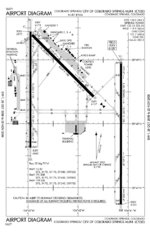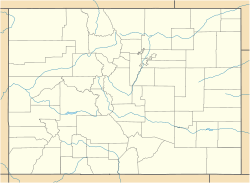- Colorado Springs Airport
-
Colorado Springs Airport
City of Colorado Springs Municipal Airport
FAA airport diagram IATA: COS – ICAO: KCOS – FAA LID: COS Location of the Colorado Springs Airport Summary Airport type Public Owner City of Colorado Springs Serves Colorado Springs, Colorado Elevation AMSL 6,187 ft / 1,886 m Coordinates 38°48′21″N 104°42′03″W / 38.80583°N 104.70083°W Website Runways Direction Length Surface ft m 17L/35R 13,501 4,115 Concrete 17R/35L 11,022 3,360 Asphalt 12/30 8,269 2,520 Asphalt Statistics (2006) Aircraft operations 153,244 Based aircraft 292 Sources: airport web site[1] and FAA[2] Colorado Springs Airport[1] (IATA: COS, ICAO: KCOS, FAA LID: COS), also known as the City of Colorado Springs Municipal Airport,[2] is a city-owned, public-use, joint civil-military airport located six miles (10 km) southeast of the central business district of Colorado Springs, a city in El Paso County, Colorado, United States.[2] It is the second busiest airport in the state of Colorado. The airport is co-located with Peterson Air Force Base, which is located along the north side of runway 12/30.
Contents
History
The airport was founded in 1927, the same year Charles Lindbergh made his transatlantic flight. Originally the airport covered an area of 640 acres (2.6 km²) and had two gravel runways. By the late 1930s the first passenger traffic was flowing through the airport on a flight that ran from El Paso, Texas, through Pueblo, Colorado Springs, and Denver, then back again. The original site was the present day location of the northern municipal power plant, east of Nevada Avenue and south of Winters Street. The first terminal was built in 1940 in an art deco style.
Soon after the terminal was built, the field was taken over by the military in the months preceding World War II. After the war, the city regained operations at the airport.
In 1966, a new terminal was built on the west side of the runways, at a new site east of Colorado Springs beyond Powers Boulevard. This terminal was expanded several times throughout the 1970s and 80s. By 1991, the airport consisted of three 150-foot (46 m) wide runways, one of which had a length of 13,501 feet (4,115 m), making it the longest runway in Colorado until 16R/34L, a 16,000-foot (4,900 m) long runway, opened at Denver International Airport in September 2003. By 1991, the old terminal could no longer handle the increasing passenger traffic, and the city approved the building of a new terminal on the south side of the airfield.
The new terminal, a 280,000-square-foot (26,000 m2), 17-gate facility cost $140 million dollars to build. It was opened on October 22, 1994.[3]
Operations
Through the 1970s, 1980s and 1990s, the airport was constantly adding new fares and expanding service. The largest number of passenger arriving and departing the Colorado Springs Airport was in 1996, when the airport handled nearly 5 million passengers. At that time the now defunct Western Pacific Airlines had a hub at the airport. The airline moved their hub to Denver International Airport in late 1996, which caused an abrupt decline in passenger traffic.
Colorado Springs continues to expand service and now offers non-stop service to eleven U.S. cities. Most of the cities that can be reached from the airport are hubs for major airlines. However, Colorado Springs has seen sporadic service to several non-hub cities in recent years.
Facilities and aircraft
City of Colorado Springs Municipal Airport covers an area of 7,200 acres (2,900 ha) which contains three paved runways: 17L/35R measuring 13,501 x 150 ft (4,115 x 46 m), 17R/35L measuring 11,022 x 150 ft (3,360 x 46 m) and 12/30 measuring 8,269 x 150 ft (2,520 x 46 m).[2]
The passenger terminal, centrally located on the airport grounds and accessible from Milton Proby Parkway, connects to two concourses. Of the two concourses, only the main portion (gates 1-12) is in use. The second concourse (called the Western Pacific Airlines concourse) is not in active use and provides gates 14-18 (there is no gate 13.) The second concourse is now primarily used for meetings. Access between the concourses requires leaving the secure area and traversing the main terminal, down a long hallway, and entering a pair of sliding glass doors.
Beginning in September, 2011, the main airport terminal is undergoing renovation. The project includes reconstruction of the TSA checkpoint to support full-body scanners, an expansion of the office space behind the ticket counters, and facilities for automated baggage screening in the baggage rooms.
Repairs to runway 17L/35R, originally scheduled for 2011 but delayed by the FAA shutdown, will begin in spring 2012.
For the 12-month period ending January 31, 2006, the airport had 153,244 aircraft operations, an average of 419 per day: 58% general aviation, 18% air taxi, 14% scheduled commercial and 11% military. At that time there were 292 aircraft based at this airport: 50% single-engine, 22% multi-engine, 12% jet, 1% helicopter and 16% military.[2]
The single 16-gate passenger terminal opened on October 22, 1994. It currently serves over 2 million passengers annually.[3]
Airlines and destinations
Airlines Destinations Allegiant Air Las Vegas, Phoenix/Mesa American Airlines Dallas/Fort Worth Continental Express operated by ExpressJet Airlines Houston-Intercontinental Delta Air Lines Atlanta Delta Connection operated by SkyWest Airlines Minneapolis/St. Paul, Salt Lake City Frontier Airlines operated by Republic Airlines Denver United Express operated by Mesa Airlines Chicago-O'Hare United Express operated by SkyWest Airlines Chicago-O'Hare, Denver, Houston-Intercontinental, Los Angeles, San Francisco, Washington-Dulles Accidents and incidents
- On March 3, 1991, United Airlines Flight 585, a Boeing 737-291 flying from Peoria, Illinois, to Colorado Springs via Moline, Illinois, and Denver, Colorado, crashed on final approach to Colorado Springs Runway 35 after a rudder malfunction caused the aircraft to roll over and dive, killing all 25 on board. The incident was officially closed as undetermined but after investigating a nearly identical crash involving USAir Flight 427 in Aliquippa, Pennsylvania, as well as another nearly identical incident involving Eastwind Airlines Flight 517 in 1996 in Richmond, Virginia, the cause of the accident was finally determined. The reason was the effect of thermal shock on the rudder which blocked it entirely. The pilot tried to change the direction of the rudder but another effect of thermal shock was the reverse action of the pedals. The pilot flying pushed on the pedals but this contributed to the out-of-control diving of the aircraft since he was not aware of the reverse action of the pedals.
- On January 8, 2010, a 47-year-old man from Virginia by the name of Muhammad Abu Tahir became intoxicated on AirTran Airways flight 39 bound for San Francisco after it left Atlanta, forcing the plane to make an emergency landing in Colorado Springs. The plane landed with no issues and Tahir was arrested and taken to an El Paso County jail and later charged. The plane took off again from Colorado Springs for San Francisco several hours later.[4]
- On December 30, 2010, a Delta Air Lines Boeing 757-300 operating as Flight 1921 from Detroit Metropolitan Wayne County Airport to Phoenix Sky Harbor International Airport with 225 passengers and crew had to make an emergency landing at the airport due to engine problems. Two people were injured during evacuation.
See also
References
External links
- Colorado Springs Municipal Airport at Colorado DOT website
- FAA Airport Diagram (PDF), effective 20 October 2011
- Resources for this airport:
- AirNav airport information for KCOS
- ASN accident history for COS
- FlightAware airport information and live flight tracker
- NOAA/NWS latest weather observations
- SkyVector aeronautical chart for KCOS
- FAA current COS delay information
U.S. National Register of Historic Places Topics Lists by states Alabama • Alaska • Arizona • Arkansas • California • Colorado • Connecticut • Delaware • Florida • Georgia • Hawaii • Idaho • Illinois • Indiana • Iowa • Kansas • Kentucky • Louisiana • Maine • Maryland • Massachusetts • Michigan • Minnesota • Mississippi • Missouri • Montana • Nebraska • Nevada • New Hampshire • New Jersey • New Mexico • New York • North Carolina • North Dakota • Ohio • Oklahoma • Oregon • Pennsylvania • Rhode Island • South Carolina • South Dakota • Tennessee • Texas • Utah • Vermont • Virginia • Washington • West Virginia • Wisconsin • WyomingLists by territories Lists by associated states Other  Category:National Register of Historic Places •
Category:National Register of Historic Places •  Portal:National Register of Historic PlacesCategories:
Portal:National Register of Historic PlacesCategories:- Airports in Colorado
- Transportation in Colorado Springs, Colorado
- National Register of Historic Places in Colorado
- Buildings and structures in Colorado Springs, Colorado
- Tourism in Colorado Springs
- Historic districts in Colorado
Wikimedia Foundation. 2010.


